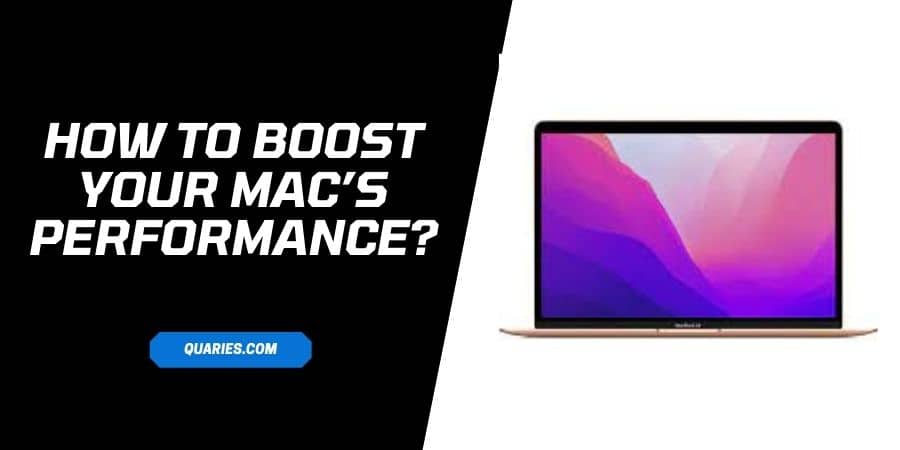A poorly performing MacBook can lead you to poor efficiency at work or studies. The issue is particularly problematic when you have strict deadlines and every minute counts.
Having a computer that does not feel sluggish and works with next to no faults is a different experience.
In case you have noticed that there are problems with your MacBook, and the performance is only getting worse, do not expect that the situation will solve itself. That is unlikely. Instead, you need to be proactive and get to solving the problems.

Below, you will find 10 valuable ways that will help boost your Mac’s performance. Take the information and make the most out of it while creating your own maintenance routine for a MacBook. And remember that you should do these things regularly.
How To Boost Your Sluggish Mac’s Performance?
1. Work on Finding Potential Malware
Despite the fact that macOS is not as prone to cybersecurity threats, you should not underestimate how many different viruses and malware you can encounter. The severity of these threats also varies from minor to quite problematic, including the worse overall performance of a computer.
If you practice safe internet browsing, then the odds of encountering cybersecurity threats are also minimal. Nevertheless, it is still possible that there is a virus or malware on your Mac, and it is precisely why you are facing difficulties using the computer.
Use a reliable anti-malware tool to scan the device for threats and see if the tool detects any corrupted data. A clean scan indicates that the issues are not there. On the other hand, if your antivirus finds potentially dangerous files, you will need to remove them from the MacBook.
2. Free Up Drive Storage
Running out of disk space is not that difficult if you have a habit of hoarding files on a computer, particularly if we are talking about large media files, such as movies or TV shows.
You need to take a look at the drive and see what files are there. You are bound to find some stuff that is no longer useful and remove it.
Coming back to the media files, instead of keeping them on Mac’s drive, stick to streaming platforms and consume media on the go.
Another good piece of advice is to get a cleanup utility tool and remove temporary system clutter. Not only will it free up storage, but it will also leave fewer files for the system to deal with.
Finally, consider transferring some files to external storage, such as HDDs, USB flash sticks, and iCloud.
3. Clean Dust Inside the Computer
Cleaning the dust inside a Mac is a bit tricky due to the fact that you need to take the computer apart to clean the filth thoroughly.
It might be for the best to leave this particular task to someone with experience. If you were to clean the dust yourself with no prior knowledge, the odds of damaging the computer and doing more harm are pretty high.
4. See If It Is Possible to Upgrade Hardware
Hardware upgrades are not really a thing for MacBooks, particularly when it comes to the most recent models.
On the other hand, it is possible that your Mac is compatible with hardware upgrades, and if you have the money for it, then you should consider:
- Getting an external graphics processing unit
- Adding extra RAM
- Replacing a hard drive with a solid-state drive
The three upgrades mentioned above are the most popular, and they make a significant difference.
5. Get Rid of the Desktop Clutter
Quite a few computer users like to keep documents and various shortcuts on the desktop to access the files without using the search function on the device or navigating through different directories manually.
The problem with this habit is that it can get out of hand, and the number of desktop files could reach a point where it causes problems for the computer’s performance.
Desktop icons consume system resources, particularly when you switch between the desktop and other tabs.
It is recommended not to keep files on the desktop and use appropriate locations for them instead.
6. Check If macOS Runs on the Latest Version
You might have missed a macOS, which means that the version is not up to date. Not having the latest operating system version means missing out on potential performance updates.
Unless an update is major (which you should install right away), it will not take too long to download and install it.
7. Optimize Internet Browser
For some MacBook owners, the problem could lie not in the device’s performance but the internet browser. In case your Wi-Fi connection is fine, but it still takes too long for websites to load, or you notice random crashes or freezes, try to tinker with your internet browser.
It is possible that you installed too many redundant extensions. The amount of browser cache might have reached the limit as well, so clear it.
8. Invest in a Cooling Pad
A cooling pad that costs no more than 50 dollars is a great investment, given that it can do wonders for the MacBook’s performance. If you notice that the computer is overheating or that the noise coming from the internal fans is really loud, your first instinct should be to remove the dust inside the device.
However, there are instances when that is not enough, and you need to seek other ways to salvage the situation. A cooling pad can be an answer to this problem.
9. Minimize Redundant Background and Startup Apps
Minimizing background applications and killing off unnecessary visual effects will help free up system resources and boost the MacBook’s performance.
In addition, the battery lifespan will increase once there are fewer sources of consumption. You can also see this page for more on the battery problems in case you are fed up with having to charge the MacBook too frequently.
10. Solve the Memory Leak Problem
Memory leaks happen when a computer runs for too long without taking a break. The distribution of memory from applications goes all over the place, and it slows down the system.
The simplest solution to this problem is to restart the MacBook. Ideally, you should try to restart the device every few hours.
Like This Post? Checkout More
